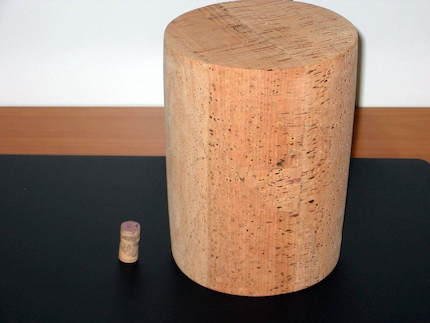

Magnum vs Goliath? A quick guide to wine bottle sizes
Bottled wine comes in defined sizes that follow strict rules. The name of these wine bottle sizes, however, seems quite arbitrary. Let me give you an overview.
While recording our Swiss German podcast «Uftischt», we got into a discussion about the sizes and names of wine bottles. Admittedly, I gave Judith a slightly chauvinistic explanation of the magnum bottle size – in other words, I excelled in mansplaining. And Judith countered this by overestimating the size of one of her body parts in a way that usually only men do.
You’ll find the full podcast episode here.
Now you might say: «But that podcast was released three days ago! Wine improves with age, but podcasts don’t!» To which I’d reply: «Speaking of aging well, did you know that wine used to be stored in animal skin tubes and therefore didn’t age well at all? In fact, it became undrinkable really quickly.»
There we go. I’m mansplaining again. In this article, I’m going to round up the discussion I started in the podcast. Let’s talk about the sizes of wine bottles.
Why are there oversized bottles anyway?
The most popular size for wine bottles is 7.5 decilitres – or 750 millilitres, as it usually says on the label. Why is this the most common size? That’s not entirely clear. One theory is that it used to be easier for glassblowers to produce this size because it corresponds to the average lung volume. Another theory says it’s because when shipping to England, a crate of wine needed to contain exactly 2 gallons (or around 9 litres) of wine. That’s 12 bottles. A third theory suggests the size of wine glasses determined the size of the bottles. According to this theory, a glass of wine was a decilitre, plus a small extra to make customers feel good. So a 0.75 litre bottle would fill six glasses of wine.
When it comes to wine bottles, bigger is better
It can’t be a quality decision. In fact, wine from larger bottles is considered to be better, as thicker glass keeps the temperature constant and there’s relatively little oxygen in the bottle in relation to the amount of wine. Too much oxygen is poison for wine, as it causes it to oxidise. Therefore, what chauvinists may wrongly assume is actually true for wine: bigger is better. And proportionally more expensive, too.
To keep the maths simple, bottle sizes are always a multiple or a fraction of 0.75. There is, for example, a 0.375-litre bottle designed for one person. And all larger bottles have names – often those of biblical kings.
Magnum: 1.5 litres
The name of the most famous large bottle has nothing to do with the moustached private investigator who starred in a TV series I used to watch as a child. «Magnum» is Latin for «great».



Perrier-Jouët Grand Brut Magnum 1.5 L in gift box
1 x 150 cl
Jeroboam: 3 litres
Jeroboam was the first king of Israel in 900 BC. If you can’t remember the name, just call it double magnum.



Moët & Chandon Jeroboam Brut Imperial Champagne in wooden box
1 x 300 cl
Rehoboam: 4.5 litres
Rehoboam was also a king from around 900 BC – the king of the kingdom of Judah, south of Israel. We’ll come across his father Solomon later on. This bottle size is quite rare.
Methusalem: 6 litres
According to the Bible, Methuselah, the grandfather of Noah and forefather before the Flood, lived to be almost 1,000 years old. In German, the name is also used in a figurative sense for older members of a group. This 6-litre bottle is also called an «Impérial», the imperial bottle.
Salmanazar: 9 litres
We leave the Promised Land for King Salmanazar, who ruled over the Assyrian Empire in northern Mesopotamia in 850 BC. Today, his kingdom would extend across northern Iraq, north-eastern Syria, south-eastern Turkey and north-western Iran.
Balthazar: 12 litres
Fast forward a few hundred years and we meet one of the Three Wise Men – the one who’s said to have brought myrrh. Supposedly, Jesus was even offered wine laced with myrrh when he was on the cross. Whether it was twelve litres isn’t known.
Nebuchadnezzar: 15 litres
Not just one, but four kings of ancient Babylonia were called Nebuchadnezzar. The best known is probably Nebuchadnezzar II, under whose reign the Tower of Babel as well as the Hanging Gardens of Babylon were completed. The latter are among the original seven wonders of the world.
Melchior or Goliath: 18 litres
This wine bottle size is named after the second of the Three Wise Men who gave gifts to Jesus. The third one, Kaspar, wasn’t chosen to name a bottle – for whatever reason. Another common name for this bottle is Goliath. This is a somewhat unusual name, as it’s not the name of a biblical king, but a giant warrior who was brought to his knees by the smaller David. David and Goliath also feature in the Bible, though.
Salomon: 20 litres
The builder of the Jewish temple in Jerusalem concludes our list of oversized wine bottles. There are other sizes, but we don’t have any larger ones in our shop.
The largest ever wine bottle
The record for the largest wine bottle – 480 litres – is held by Kracher winery in Burgenland, Austria. Its cork alone looks bizarre compared to a regular one.

Source: Gasthaus zum Gupf
This bottle’s in the cellar of restaurant Gupf in Rehetobel, Switzerland.
Click here to listen to the Swiss-German podcast «Uftischt» on Spotify or here to subscribe to it in the app you use.
When I flew the family nest over 15 years ago, I suddenly had to cook for myself. But it wasn’t long until this necessity became a virtue. Today, rattling those pots and pans is a fundamental part of my life. I’m a true foodie and devour everything from junk food to star-awarded cuisine. Literally. I eat way too fast.
Interesting facts about products, behind-the-scenes looks at manufacturers and deep-dives on interesting people.
Show all











